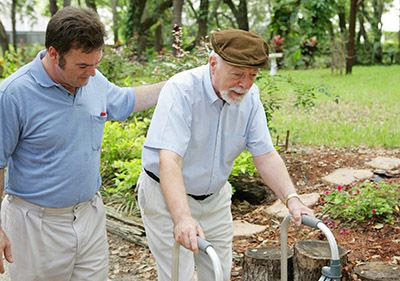 Several members of the Tulane Neurology faculty are fellowship trained in the diagnosis and management of Movement Disorders. These physicians include: Dr. Neda Hidarilak and Dr. Sarah Perez. Dr. Hidarilak has appointments available at the Tulane Doctors Neurosciences - Covington Clinic, and the Tulane Medical Center Neuroscience Center. Dr. Perez has appointments available at the Tulane Doctors Neurosciences - Covington Clinic, and Tulane Doctors Neurosciences - Metairie Clinic.
Several members of the Tulane Neurology faculty are fellowship trained in the diagnosis and management of Movement Disorders. These physicians include: Dr. Neda Hidarilak and Dr. Sarah Perez. Dr. Hidarilak has appointments available at the Tulane Doctors Neurosciences - Covington Clinic, and the Tulane Medical Center Neuroscience Center. Dr. Perez has appointments available at the Tulane Doctors Neurosciences - Covington Clinic, and Tulane Doctors Neurosciences - Metairie Clinic.
Movement Disorders are characterized by abnormal movements such as tremor or chorea. Probably the most common cause of tremor is medication effect as a number of medications have tremor as a potential side effect. However, the topic of Movement Disorders is most often highlighted by Parkinson’s Disease. This is related to the fairly dramatic manifestations, which evolve over time, as well as high profile personalities with the disease such as Michael J. Fox and Mohammed Ali. However, essential (or familial) tremor is more common, but tends to be more of a nuisance type of presentation characterized by postural tremor. To learn more about Movement Disorders please visit Tulane Doctors Neurosciences.
Parkinson’s disease traditionally has resting tremor, described as “pin-rolling”, as a primary manifestation along with a type of increased motor tone termed rigidity, as well as slowing down of movements termed “bradykinesia”. The combination of the tremor with the rigidity can produce a “cogwheel” type of phenomenon when testing tone in the upper extremities in this disorder. Such “cogwheel-type” rigidity tends to become more prominent when the other extremity is moving in a repetitive fashion and this has been termed “contralateral stimulation”. Parkinson’s disease now affects millions of people in the United States and is seen with increasing incidence at 60 years of age and beyond. Over time, the patient tends to develop a flexed posture along with increasing difficulty with postural stability resulting in a tendency to fall. A festinating gait can develop where the person rushes forward in small steps in an attempt to correct their center of gravity. Some patients with Parkinson’s disease suffer significant dementia and there is an overlap disorder called “Dementia with Lewy bodies” characterized by features of Parkinson’s disease, termed parkinsonism, as well as dementia along with visual hallucinations. Parkinsonism can be seen with certain toxic exposure such as carbon monoxide poisoning or manganese poisoning. There can also be features of parkinsonism after stroke affecting the brain structure typically involved in Parkinson’s disease termed the “basal ganglia”. In addition, medications can promote features of Parkinson’s disease including neuroleptic (anti-psychotic) medications such as Thorazine, Stelazine and Haldol as well as the gastrointestinal agent metoclopramide (Reglan).
Parkinson’s disease is primarily a clinical diagnosis based upon the characteristic features. There are now special radionuclide brain scans that can help in determining if the clinical diagnosis is compatible with a pathophysiological picture of dopamine deficiency in the brain. Parkinson’s disease tends to be very treatable, at least initially, in recognition that dopamine replacement with levodopa or agents which stimulate the dopamine brain receptors, termed dopamine agonists, can be very beneficial. Many patients look essentially cured with initial treatment. Unfortunately, as the disease progresses, roughly over 3 to 5 years, there is often progressive loss of responsiveness to presently available medications. Fortunately, newer agents are becoming available and the armamentarium can now include procedures such as special brain surgery termed deep brain stimulation (DBS).
A not uncommon disorder is essential tremor which is a postural tremor which tends to be most noticeable when performing tasks such as handwriting and holding a cup of coffee or tea. It tends to be suppressed by alcohol-containing beverages which is an important aspect of the history. When such a tremor occurs in families, it is termed “familial tremor”. It can vary in severity from mild to moderate to severe and delicate surgical intervention of the brain is now available for patients with severe tremor resulting in significant functional limitation. Otherwise, medications including beta-blockers, such as propranolol, and primidone can be helpful in suppressing the tremor to a significant degree. Alcohol consumption can also suppress the tremor and, when used in moderation, can help the patient adjust to social engagements where they may be embarrassed by their tremor.
Huntington’s disease also falls into the Movement Disorder category. This is characterized by autosomal dominant inheritance, whereby there is a 50-50 chance of the children eventually being affected if a parent is affected, jerking and writhing type movements termed choreo-athetosis, and there can be cognitive and behavioral involvement. Unfortunately, this illness often progresses to a significantly incapacitating condition within a finite period of time. There is a blood test now available to help confirm the diagnosis on a genetic basis. Unfortunately, the treatments presently available tend to be modest in terms of their degree of benefit.
